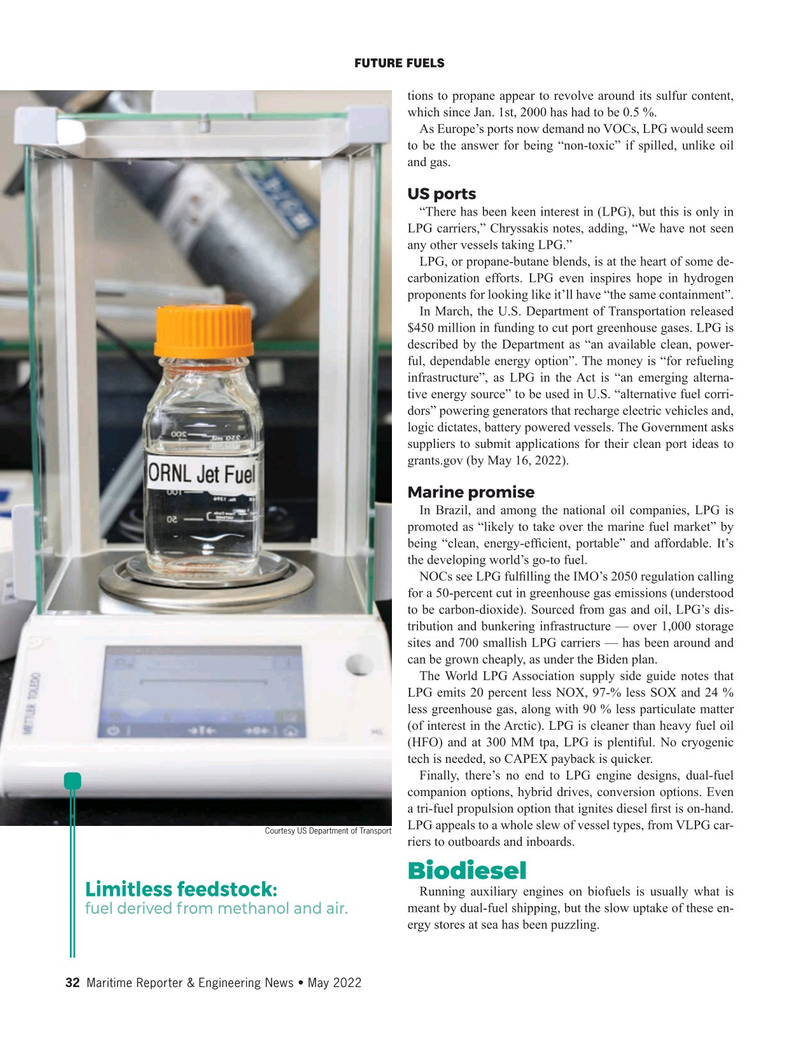
Page 32: of Maritime Reporter Magazine (May 2022)
Green Ship Technologies
Read this page in Pdf, Flash or Html5 edition of May 2022 Maritime Reporter Magazine
FUTURE FUELS tions to propane appear to revolve around its sulfur content, which since Jan. 1st, 2000 has had to be 0.5 %.
As Europe’s ports now demand no VOCs, LPG would seem to be the answer for being “non-toxic” if spilled, unlike oil and gas.
US ports “There has been keen interest in (LPG), but this is only in
LPG carriers,” Chryssakis notes, adding, “We have not seen any other vessels taking LPG.”
LPG, or propane-butane blends, is at the heart of some de- carbonization efforts. LPG even inspires hope in hydrogen proponents for looking like it’ll have “the same containment”.
In March, the U.S. Department of Transportation released $450 million in funding to cut port greenhouse gases. LPG is described by the Department as “an available clean, power- ful, dependable energy option”. The money is “for refueling infrastructure”, as LPG in the Act is “an emerging alterna- tive energy source” to be used in U.S. “alternative fuel corri- dors” powering generators that recharge electric vehicles and, logic dictates, battery powered vessels. The Government asks suppliers to submit applications for their clean port ideas to grants.gov (by May 16, 2022).
Marine promise
In Brazil, and among the national oil companies, LPG is promoted as “likely to take over the marine fuel market” by being “clean, energy-ef? cient, portable” and affordable. It’s the developing world’s go-to fuel.
NOCs see LPG ful? lling the IMO’s 2050 regulation calling for a 50-percent cut in greenhouse gas emissions (understood to be carbon-dioxide). Sourced from gas and oil, LPG’s dis- tribution and bunkering infrastructure — over 1,000 storage sites and 700 smallish LPG carriers — has been around and can be grown cheaply, as under the Biden plan.
The World LPG Association supply side guide notes that
LPG emits 20 percent less NOX, 97-% less SOX and 24 % less greenhouse gas, along with 90 % less particulate matter (of interest in the Arctic). LPG is cleaner than heavy fuel oil (HFO) and at 300 MM tpa, LPG is plentiful. No cryogenic tech is needed, so CAPEX payback is quicker.
Finally, there’s no end to LPG engine designs, dual-fuel companion options, hybrid drives, conversion options. Even a tri-fuel propulsion option that ignites diesel ? rst is on-hand.
LPG appeals to a whole slew of vessel types, from VLPG car-
Courtesy US Department of Transport riers to outboards and inboards.
Biodiesel
Running auxiliary engines on biofuels is usually what is
Limitless feedstock: meant by dual-fuel shipping, but the slow uptake of these en- fuel derived from methanol and air.
ergy stores at sea has been puzzling.
32 Maritime Reporter & Engineering News • May 2022
MR #5 (18-33).indd 32 5/3/2022 9:30:28 AM

 31
31

 33
33
